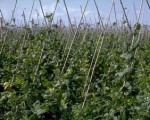 Growing beans, green or wax, is very easy and rewarding and some of them can even be grown in containers. Once you have decided on the kind of bean you wish to grow pick a sunny site with well-drained, fertile soil. Beans are warm weather crops so you have to have frost-free nights and warm soil (65 F) in order to plant them.
Growing beans, green or wax, is very easy and rewarding and some of them can even be grown in containers. Once you have decided on the kind of bean you wish to grow pick a sunny site with well-drained, fertile soil. Beans are warm weather crops so you have to have frost-free nights and warm soil (65 F) in order to plant them.
Planting Bush Beans (Green or Wax)
With a hoe, make a furrow the length of your garden row and about an inch deep. Place the bean seeds 2” apart and cover with 1” of soil. If you plant more than one row, space the rows 2’-2 ½’ apart to reduce the possibility of disease. This is also a good time to apply manure, compost or a fertilizer with a ratio of 1:2:1: (nitrogen-phosphorous-potassium). If commercial fertilizer is used apply it in a furrow next to the beans. High nitrogen (first number) fertilizers will produce excessive leaf growth so avoid them. Water well. When the seedlings emerge thin to 3”-4” apart.
Bush beans produce all their beans in a 2 week period so if you wish to have a continuous supply of beans sow new rows every 2 weeks (or grow pole beans because they have a longer period of production.
Bush beans can be grown in containers. Provide 8″12″ of soil and a top quality potting soil. Water and fertilize regularly.

Planting Pole Beans
Pole beans need support so plant them in hills or mounds about 3’ apart or in rows 3’ apart. Plant 3-4 seed in a mound 1” deep around a pole or plant a row of beans 4”-5” apart and 1” deep. When seedlings emerge thin so that seedling are 9”-12” apart. Apply fertilizer as for bush beans and water in.
Provide support for your pole beans and help them start their twining process by lifting them on to the support at the proper. A pole in the middle of a mound works but a teepee made of 8’ long 1”x1”s is very picturesque as well as effective. If you planted a row of pole beans, a trellis, fence, or net can provide support. The plants get large and heavy as they grow and bear fruit (beans) so make sure that your support is sturdy.
Care of Bush and Pole Beans
Fertilize you beans monthly using a high phosphorous (middle number). Water weekly at the base of the bean plants during periods of dryness. Avoid wetting to foliage to reduce the possibility of disease. Beans have shallow roots, so be careful not to disturb the roots when you cultivate and remove weeds.
The Mexican bean beetle can ravage your beans. Manually pick of the beetles and check for eggs on the underside of leaves. Remove any infected leaves.
Many of the diseases that attack beans can be avoided by proper cultivation practices; keep the foliage dry and rotate the placement of beans in your garden every year.
Harvesting Bush or Pole Beans
Harvest the beans when the pods are crisp, firm and fully elongated but before the beans inside have enlarged. Pick when the foliage is dry (to reduce the possibility of disease) and handle the beans and plants carefully to avoid breaking the branches when you nip the bean off the plant. Harvest pole beans regularly to encourage further bean production.
Beans are delicious as a vegetable side dish but can cooled after cooking and used in summer salads. Hot bean pickles are a real treat!

A nice and thorough roundup on beans. I particularly like how you discuss their fertilizing and watering requirements in detail, relating it to the structure of the plant.
Thanks for your comment. I think understanding “why” something is so makes it easier to remember.